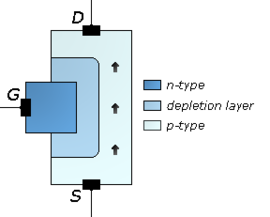JFET

Electric current from source to drain in a p-channel JFET is restricted when a voltage is applied to the gate.
|
|
| Type | Active |
|---|---|
| Pin configuration | drain, gate, source |
| Electronic symbol | |
 
|
|
The junction gate field-effect transistor (JFET or JUGFET) is the simplest type of field-effect transistor. They are three-terminal semiconductor devices that can be used as electronically-controlled switches, amplifiers, or voltage-controlled resistors.
Unlike bipolar transistors, JFETs are exclusively voltage-controlled in that they do not need a biasing current. Electric charge flows through a semiconducting channel between source and drain terminals. By applying a reverse bias voltage to a gate terminal, the channel is "pinched", so that the electric current is impeded or switched off completely. A JFET is usually on when there is no potential difference between its gate and source terminals. If a potential difference of the proper polarity is applied between its gate and source terminals, the JFET will be more resistive to current flow, which means less current would flow in the channel between the source and drain terminals. Thus, JFETs are sometimes referred to as depletion-mode devices.
JFETs can have an n-type or p-type channel. In the n-type, if the voltage applied to the gate is less than that applied to the source, the current will be reduced (similarly in the p-type, if the voltage applied to the gate is greater than that applied to the source). A JFET has a large input impedance (sometimes on the order of 1010 ohms), which means that it has a negligible effect on external components or circuits connected to its gate.
A succession of FET-like devices were patented by Julius Lilienfeld in the 1920s and 1930s.However, materials science and fabrication technology would require decades of advances before FETs could actually be made. In 1947, researchers John Bardeen, Walter Houser Brattain, and William Shockley failed in their repeated attempts to make a FET. They discovered the point-contact transistor in the course of trying to diagnose the reasons for their failures. The first practical JFETs were made a decade later.
...
Wikipedia
